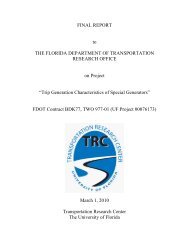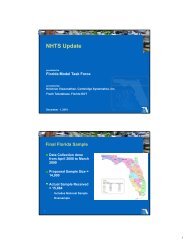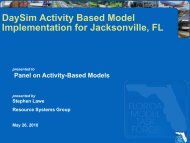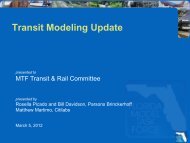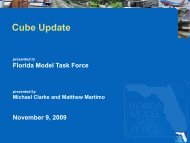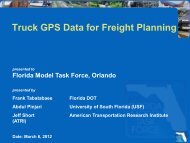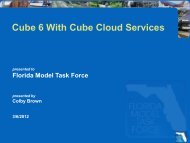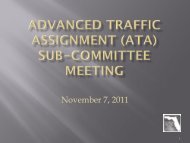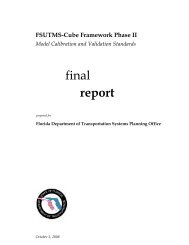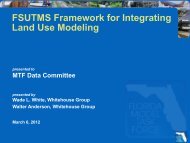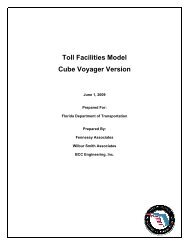Comparing Operational Activity- Based Models ... - FSUTMSOnline
Comparing Operational Activity- Based Models ... - FSUTMSOnline
Comparing Operational Activity- Based Models ... - FSUTMSOnline
You also want an ePaper? Increase the reach of your titles
YUMPU automatically turns print PDFs into web optimized ePapers that Google loves.
<strong>Comparing</strong> <strong>Operational</strong> <strong>Activity</strong>-<br />
<strong>Based</strong> <strong>Models</strong> (ABMs):<br />
What is Different and What is Not?<br />
Siva Srinivasan<br />
Associate Professor<br />
Transportation Research Center<br />
Dept. of Civil & Coastal Engg.<br />
FSUTMS Users Group Meeting, Ft. Lauderdale June 1, 2012
Presentation Outline<br />
• What is the Issue?<br />
• Why does it Matter?<br />
• Conceptual and <strong>Operational</strong> Similarities<br />
• Structural and Implementation Differences<br />
• Summary and Closing Thoughts
The Structure of Travel Demand <strong>Models</strong><br />
Socio-Economic<br />
Characteristics<br />
Land Use<br />
Characteristics<br />
Transportation System<br />
Characteristics<br />
Travel-<br />
Demand<br />
Model<br />
Link Volumes,<br />
Speeds, Travel<br />
Times,…
The Structure of Travel Demand <strong>Models</strong><br />
The Trip-<strong>Based</strong> or Four-Step Structure<br />
Socio-Economic<br />
Characteristics<br />
Land Use<br />
Characteristics<br />
Transportation System<br />
Characteristics<br />
Trip Generation<br />
(frequency)<br />
Trip Distribution<br />
(destination)<br />
Largely Similar Structures for all Regions!<br />
Mode Split<br />
(mode)<br />
Network Assignment<br />
(route)<br />
Link Volumes,<br />
Speeds, Travel<br />
Times,…
The Structure of Travel Demand <strong>Models</strong><br />
Socio-Economic<br />
Characteristics<br />
Land Use<br />
Characteristics<br />
Transportation System<br />
Characteristics<br />
Detailed /<br />
Disaggregate<br />
Inputs<br />
<strong>Activity</strong>-<br />
<strong>Based</strong><br />
Travel-<br />
Demand<br />
Model<br />
Detailed daily<br />
travel patterns of<br />
the population<br />
Link Volumes,<br />
Speeds, Travel<br />
Times,…
ABMs in the United States
ABMs in the United States<br />
The CT-RAMP Family<br />
The DaySim Family<br />
New York*<br />
Columbus<br />
Bay Area MTC<br />
Atlanta<br />
San Diego<br />
Phoenix<br />
Chicago<br />
Miami<br />
…more<br />
Portland METRO**<br />
San Francisco County<br />
Sacramento<br />
Seattle<br />
Denver<br />
Philadelphia<br />
Tampa<br />
Jacksonville<br />
…more<br />
*The New York Best Practice Model pre-dates the name CT-RAMP<br />
** The earliest implementation (1998) No longer in use
The Two Major <strong>Operational</strong> Frameworks<br />
The DaySim Family<br />
The CT-RAMP Family
Academic <strong>Models</strong><br />
CEMDAP - Dallas*, Los Angeles<br />
AMOS - SE Florida*, Phoenix*<br />
TASHA - Toronto*<br />
ALBATROSS - Netherlands<br />
ADAPTS<br />
DASH<br />
…more<br />
*Prototype regions
The Structure of Travel Demand <strong>Models</strong><br />
Socio-Economic<br />
Characteristics<br />
Land Use<br />
Characteristics<br />
Transportation System<br />
Characteristics<br />
Detailed /<br />
Disaggregate<br />
Inputs<br />
<strong>Activity</strong>-<br />
<strong>Based</strong><br />
Travel-<br />
Demand<br />
Model<br />
No Single “Standard” Structure (Yet)!<br />
Detailed daily<br />
travel patterns of<br />
the population<br />
Link Volumes,<br />
Speeds, Travel<br />
Times,…
Okay, the <strong>Models</strong> are Different…<br />
So what?<br />
Why does it Matter?
Why does it Matter?<br />
To the Profession in General…..<br />
Awareness !
Why does it Matter?<br />
To a region considering a ABM…..<br />
The “research” approach<br />
The “real world” approach<br />
Assess Needs and Resources<br />
Assess Needs and Resources<br />
Develop a Modeling<br />
Framework<br />
Collect Data / Build <strong>Models</strong><br />
Implement in Software<br />
Which One?<br />
Borrow an existing framework,<br />
software<br />
Adjust / Adapt to local<br />
conditions (collect some data,<br />
build some models)<br />
Use , maintain, update<br />
Use , maintain, update
Why does it Matter?<br />
To a State DOT…….<br />
Other<br />
Areas: ??<br />
TBRPM:<br />
Standardization DaySim ?<br />
NFRPM:<br />
DaySim<br />
CFRPM:<br />
??<br />
SERPM:<br />
CT-RAMP
Why does it Matter?<br />
To a Consultant / Model User……..<br />
Knowledge and Communication
Why does it Matter?<br />
To a Software Vendor……..<br />
Software Design and Optimization
Why does it Matter?<br />
Socio-Economic<br />
Characteristics<br />
Land Use<br />
Characteristics<br />
Transportation System<br />
Characteristics<br />
Detailed /<br />
Disaggregate<br />
Inputs<br />
To the Profession in General…..<br />
<strong>Activity</strong>-<br />
<strong>Based</strong><br />
Travel-<br />
Demand<br />
Model<br />
Proactively shape the future “state of practice” model!<br />
Detailed daily<br />
travel patterns of<br />
the population<br />
Link Volumes,<br />
Speeds, Travel<br />
Times,…
Conceptual Similarities<br />
ABMs simulate travel demand is in the form of an internally-consistent<br />
“travel diaries”
Conceptual Similarities<br />
ABMs simulate travel demand is in the form of an internally-consistent<br />
“travel diaries”
Conceptual Similarities<br />
ABMs generate synthetic populations prior to similating travel demand<br />
A synthetic population is generated using aggregate socio-economic data<br />
(similar to what we currently use for 4-step models) as control totals
Conceptual Similarities<br />
ABMs distinguish between “long-term” and “short-term” choices<br />
Demographic Characteristics<br />
(Synthetic Population)<br />
long-term choices<br />
Employment & School<br />
Characteristics (location, type,<br />
flexibility)<br />
Mobility Choices (Car ownership,<br />
transponder, bus pass, ..)<br />
Daily Travel Choices (tours, mode,<br />
destination, time of day,….)
Conceptual Similarities<br />
ABMs allow policies to affect all travel choices,<br />
and differentially across population segments<br />
Multi-modal transportation system<br />
characteristics<br />
Land use and accessibility variables<br />
Individual specific “log-sum”<br />
variables<br />
<strong>Activity</strong> / Tour Generation,<br />
Mode, Destination, Time of<br />
Day, Joint Travel, ….
Conceptual Similarities<br />
Trip <strong>Based</strong> <strong>Models</strong> allow limited policy sensitivity and equal sensitivities<br />
across population groups<br />
Trip Generation Trip Distribution Mode Choice<br />
Trip Productions (P i )<br />
Zone<br />
1<br />
2<br />
Zone<br />
1<br />
2<br />
P i<br />
34<br />
66<br />
Trip Attractions (A j )<br />
A j<br />
82<br />
18<br />
From<br />
Zone<br />
Land use<br />
(employment data)<br />
1<br />
Friction factors<br />
(highway travel time)<br />
1<br />
27<br />
To Zone<br />
34<br />
66<br />
2 55 11<br />
A j<br />
Total 82 18 100<br />
2<br />
7<br />
Total<br />
P i<br />
Travel times by mode<br />
(peak and off peak)<br />
Mode<br />
Auto<br />
Transit<br />
Trips<br />
(Tijm)<br />
30<br />
25<br />
Trip Assignment<br />
Route<br />
Route A<br />
Route B<br />
Trips<br />
(Tijmr)<br />
18<br />
7
Conceptual Similarities<br />
ABMs allow policies to affect all travel choices,<br />
and differentially across population segments<br />
Drivealone<br />
5:30 pm<br />
Drivealone<br />
7:15 am<br />
8:00 am<br />
Work<br />
Home<br />
Shop<br />
5:00 pm<br />
6:30 pm<br />
Drivealone<br />
6:00 pm
Conceptual Similarities<br />
ABMs allow policies to affect all travel choices,<br />
and differentially across population segments<br />
Make a work Tour?<br />
When to start this Tour?<br />
Are there any Secondary Stops?<br />
Use the<br />
“preference”<br />
for various<br />
modes (the<br />
log-sum<br />
variable)<br />
Where (Location) is the secondary stop?<br />
Use travel<br />
times at the<br />
appropriate<br />
time of day<br />
What is the mode for Tour?
Conceptual Similarities<br />
ABMs allow policies to affect all travel choices,<br />
and differentially across population segments<br />
Make a work Tour?<br />
When to start this Tour?<br />
Use travel<br />
times to the<br />
chosen<br />
destination<br />
location<br />
Are there any Secondary Stops?<br />
Where (Location) is the secondary stop?<br />
What is the mode for Tour?<br />
Use the<br />
“preference”<br />
for various<br />
modes (the<br />
log-sum<br />
variable)
<strong>Operational</strong> Similarities<br />
ABMs focus on internal-internal travel of residents<br />
ABMs replace the first three steps of the four-step Model<br />
Zonal Socio-<br />
Economic<br />
Characteristics<br />
Zonal Land Use<br />
Characteristics<br />
Inter-Zonal Roadway<br />
Network<br />
Characteristics<br />
Inter-zonal Transit<br />
Network<br />
Characteristics<br />
Four-Step Model Structure<br />
Trip Generation<br />
Trip Distribution<br />
Mode Split<br />
Internal-Internal Travel<br />
Demand of Residents<br />
by Mode (“OD Matrix”)<br />
Total Daily Travel<br />
Demand by Mode<br />
(“OD Matrix”)<br />
External Travel (IE,EI,<br />
and EE) Demand<br />
Freight Travel<br />
Demand<br />
Non Resident Travel<br />
Demand<br />
Highway Assignment<br />
Transit Assignment
Zonal Socio-<br />
Economic<br />
Characteristics<br />
Zonal Land Use<br />
Characteristics<br />
Inter-Zonal<br />
Roadway Network<br />
Characteristics<br />
Inter-zonal Transit<br />
Network<br />
Characteristics<br />
<strong>Operational</strong> Similarities<br />
ABMs focus on internal-internal travel of residents<br />
ABMs replace the first three steps of the four-step Model<br />
<strong>Activity</strong>-based Model Structure<br />
Population<br />
Synthesizer<br />
Long Term<br />
Choices<br />
Simulator<br />
Detailed<br />
Population<br />
Characteristics<br />
<strong>Activity</strong>/Tour<br />
Generation<br />
ABM<br />
<strong>Activity</strong>/Tour<br />
Scheduling<br />
Mode Choice & Stops<br />
Location<br />
Simulated Travel Patterns of<br />
Each Person in Population<br />
Internal-Internal Travel Demand<br />
of Residents by Mode & Time of<br />
Day (“OD Matrix”)<br />
Total Travel Demand<br />
by Mode & Time of<br />
Day (“OD Matrix”)<br />
External Travel (IE,EI,<br />
and EE) Demand<br />
Freight Travel<br />
Demand<br />
Non Resident Travel<br />
Demand<br />
Highway Assignment<br />
Transit Assignment
<strong>Operational</strong> Similarities<br />
ABMs interface with popular demand forecasting software<br />
Zonal Socio-<br />
Economic<br />
Characteristics<br />
Zonal Land Use<br />
Characteristics<br />
Inter-Zonal<br />
Roadway Network<br />
Characteristics<br />
Inter-zonal Transit<br />
Network<br />
Characteristics<br />
Inputs<br />
CUBE<br />
Population<br />
Synthesizer<br />
Long Term<br />
Choices<br />
Simulator<br />
Proprietary<br />
code<br />
Detailed<br />
Population<br />
Characteristics<br />
Network<br />
Outputs &<br />
Reports<br />
<strong>Activity</strong>/Tour<br />
Generation<br />
<strong>Activity</strong>/Tour<br />
Scheduling<br />
Mode Choice & Stops<br />
Location<br />
Simulated Travel Patterns of<br />
Each Person in Population<br />
Internal-Internal Travel Demand<br />
of Residents by Mode & Time of<br />
Day (“OD Matrix”)<br />
CUBE<br />
ABM<br />
Highway Assignment<br />
Total Travel Demand<br />
by Mode & Time of<br />
Day (“OD Matrix”)<br />
Custom<br />
Visualization<br />
Program<br />
External Travel (IE,EI,<br />
and EE) Demand<br />
Freight Travel<br />
Demand<br />
CUBE<br />
Non Resident Travel<br />
Demand<br />
Transit Assignment
Structural Differences<br />
Zonal Socio-<br />
Economic<br />
Characteristics<br />
Zonal Land Use<br />
Characteristics<br />
Inter-Zonal<br />
Roadway Network<br />
Characteristics<br />
Inter-zonal Transit<br />
Network<br />
Characteristics<br />
Population<br />
Synthesizer<br />
Long Term<br />
Choices<br />
Simulator<br />
<strong>Activity</strong>-based Model Structure<br />
Detailed<br />
Population<br />
Characteristics<br />
<strong>Activity</strong>/Tour<br />
Generation<br />
ABM<br />
<strong>Activity</strong>/Tour<br />
Scheduling<br />
Mode Choice & Stops<br />
Location<br />
Simulated Travel Patterns of<br />
Each Person in Population<br />
Internal-Internal Travel Demand<br />
of Residents by Mode & Time of<br />
Day (“OD Matrix”)<br />
Total Travel Demand<br />
by Mode & Time of<br />
Day (“OD Matrix”)<br />
External Travel (IE,EI,<br />
and EE) Demand<br />
Freight Travel<br />
Demand<br />
Non Resident Travel<br />
Demand<br />
Highway Assignment<br />
Transit Assignment
Some Definitions<br />
7:15 am<br />
Home<br />
A Home-<strong>Based</strong> Tour<br />
Three trips in this tour (Home–Work, Work–Shop, Shop–Home)<br />
Two stops in this tour (Work and Shop)<br />
6:30 pm<br />
Drivealone<br />
Tour Mode =<br />
“Drive Alone”<br />
8:00 am<br />
5:00 pm<br />
Work<br />
Tour Purpose = “Work”<br />
Primary Destination/Stop<br />
Stop Duration = 9 Hours<br />
5:30 pm<br />
Shop<br />
Drivealone<br />
6:00 pm<br />
Drivealone<br />
Secondary Stop<br />
Stop Purpose = “Shop”<br />
Stop Duration = 30 minutes
Structural Differences<br />
The Day <strong>Activity</strong> Pattern (DAP) Module<br />
The first step in both DaySim and CT-RAMP models<br />
Determines what tour purposes an individual wants to undertake<br />
during the day<br />
Analogous to the “trip generation” module in the four-step model
Structural Differences<br />
The Day <strong>Activity</strong> Pattern (DAP) Module: The DaySim Approach<br />
Assume that there are two tour purposes work (W) and non-work (NW)<br />
What patterns are possible for any individual?<br />
• Neither W nor NW (at home)<br />
• Only W<br />
• Only NW<br />
• Both W and NW<br />
NOTE: Only W means one or more work tours are undertaken, the extract<br />
number of such tours is determined later
Structural Differences<br />
The Day <strong>Activity</strong> Pattern (DAP) Module: The DaySim Approach<br />
Assume that there are two tour purposes work (W) and non-work (NW)<br />
Each tour may or may not have secondary stops (trip chaining present<br />
or absent)<br />
Considering both issues above, what patterns are possible for any<br />
individual?<br />
• Neither W nor NW (at home)<br />
• Only W (w/o stops)<br />
• Only W (w stops)<br />
• Only NW (w/o stops)<br />
• Only NW (w stops)<br />
• W (w/o stops) & NW (w/o stops)<br />
• W (w/o stops) & NW (w stops)<br />
• W (w stops) & NW (w/o stops)<br />
• W (w stops) & NW (w stops)
Structural Differences<br />
The Day <strong>Activity</strong> Pattern (DAP) Module: The DaySim Approach<br />
• Neither W nor NW (at home)<br />
• Only W (w/o stops)<br />
• Only W (w stops)<br />
• Only NW (w/o stops)<br />
• Only NW (w stops)<br />
• W (w/o stops) & NW (w/o stops)<br />
• W (w/o stops) & NW (w stops)<br />
• W (w stops) & NW (w/o stops)<br />
• W (w stops) & NW (w stops)<br />
The DAP Module in DaySim which of these<br />
patterns is chosen by each person<br />
Generally seven tour purposes are<br />
considered, and so there are many, many<br />
more possible patterns
Structural Differences<br />
The Day <strong>Activity</strong> Pattern (DAP) Module: The CT-RAMP Approach<br />
For each person, the day is classified into Mandatory (M), Non-<br />
Mandatory(NM), and Home (H)<br />
For a household with two persons (workers), what patterns are<br />
possible?<br />
• M (P1) & M (P2)<br />
• M (P1) & NM (P2)<br />
• M (P1) & H (P2)<br />
• NM (P1) & M (P2)<br />
• NM (P1) & NM (P2)<br />
• NM (P1) & H (P2)<br />
• H (P1) & M (P2)<br />
• H (P1) & NM (P2)<br />
• H (P1) & H (P2)<br />
NOTE: M means one or more mandatory tours are undertaken, the extract<br />
number of such tours is determined later
Structural Differences<br />
The Day <strong>Activity</strong> Pattern (DAP) Module: The CT-RAMP Approach<br />
When neither member chooses (H), joint travel is also possible!<br />
Considering both, for a household with two persons (workers), what<br />
patterns are possible?<br />
• M (P1) & M (P2) & No Joint<br />
• M (P1) & M (P2) & Joint<br />
• M (P1) & NM (P2) & No Joint<br />
• M (P1) & NM (P2) & Joint<br />
• NM (P1) & M (P2) & No Joint<br />
• NM (P1) & M (P2) & Joint<br />
• NM (P1) & NM (P2) & No Joint<br />
• NM (P1) & NM (P2) & Joint<br />
• M (P1) & H (P2)<br />
• NM (P1) & H (P2)<br />
• H (P1) & M (P2)<br />
• H (P1) & NM (P2)<br />
• H (P1) & H (P2)
Structural Differences<br />
The Day <strong>Activity</strong> Pattern (DAP) Module: The CT-RAMP Approach<br />
• M (P1) & M (P2) & No Joint<br />
• M (P1) & M (P2) & Joint<br />
• M (P1) & NM (P2) & No Joint<br />
• M (P1) & NM (P2) & Joint<br />
• NM (P1) & M (P2) & No Joint<br />
• NM (P1) & M (P2) & Joint<br />
• NM (P1) & NM (P2) & No Joint<br />
• NM (P1) & NM (P2) & Joint<br />
• M (P1) & H (P2)<br />
• NM (P1) & H (P2)<br />
• H (P1) & M (P2)<br />
• H (P1) & NM (P2)<br />
• H (P1) & H (P2)<br />
The DAP Module in CT-RAMP which of<br />
these patterns is chosen by each<br />
household<br />
Many households have more than two<br />
persons, and so there are many, many<br />
more possible patterns
Structural Differences<br />
The Day <strong>Activity</strong> Pattern (DAP) Module<br />
DaySim’s I-DAP approach<br />
• Neither W nor NW (at home)<br />
• Only W (w/o stops)<br />
• Only W (w stops)<br />
• Only NW (w/o stops)<br />
• Only NW (w stops)<br />
• W (w/o stops) & NW (w/o stops)<br />
• W (w/o stops) & NW (w stops)<br />
• W (w stops) & NW (w/o stops)<br />
• W (w stops) & NW (w stops)<br />
CT-RAMP’s C-DAP approach<br />
• M (P1) & M (P2) & No Joint<br />
• M (P1) & M (P2) & Joint<br />
• M (P1) & NM (P2) & No Joint<br />
• M (P1) & NM (P2) & Joint<br />
• NM (P1) & M (P2) & No Joint<br />
• NM (P1) & M (P2) & Joint<br />
• NM (P1) & NM (P2) & No Joint<br />
• NM (P1) & NM (P2) & Joint<br />
• M (P1) & H (P2)<br />
• NM (P1) & H (P2)<br />
• H (P1) & M (P2)<br />
• H (P1) & NM (P2)<br />
• H (P1) & H (P2)
Structural Differences<br />
The CEMDAP approach: The Generation-Allocation Module<br />
For each child who is a student<br />
Decision to go to school<br />
Yes<br />
Work and school activity<br />
participation decisions<br />
School start time<br />
School end time<br />
Children’s travel needs<br />
and allocation of escort<br />
responsibilities<br />
For each employed adult<br />
Decision to go to work<br />
Yes<br />
Work start and end time<br />
Independent activities<br />
for personal and/or<br />
household needs<br />
Decision to undertake workrelated<br />
activities<br />
For each adult who is a student<br />
Decision to go to school<br />
Yes<br />
School start time<br />
School end time
Structural Differences<br />
The CEMDAP approach: The Generation-Allocation Module<br />
For each child going to school<br />
Mode to school<br />
Work and school activity<br />
participation decisions<br />
Mode from school<br />
Nuclear-family household<br />
Single-parent household<br />
Children’s travel needs<br />
and allocation of escort<br />
responsibilities<br />
Allocation of the drop-off episode to a parent<br />
Allocation of the pick-up episode to a parent<br />
Pick-up and/or drop-off<br />
episode allocated to the<br />
single parent<br />
Independent activities<br />
for personal and/or<br />
household needs<br />
Adjust the escorting adults’ work start time and/or work end<br />
times as appropriate to accommodate the escort activity<br />
For each child<br />
Decision to undertake joint discretionary activity with a parent<br />
Nuclear-family household<br />
Single-parent household<br />
Allocation of the joint discretionary<br />
activity to one of the parents<br />
Joint discretionary activity<br />
allocated to the single parent
Structural Differences<br />
The CEMDAP approach: The Generation-Allocation Module<br />
For each child not undertaking joint discretionary activity<br />
Decision to undertake independent discretionary activity<br />
Work and school activity<br />
participation decisions<br />
Decision of household to<br />
undertake grocery shopping<br />
Children’s travel needs<br />
and allocation of escort<br />
responsibilities<br />
No<br />
Single adult<br />
household<br />
<strong>Activity</strong> allocated to<br />
the single adult<br />
Yes<br />
Multiple adult<br />
household<br />
Allocation of the grocery shopping<br />
responsibility to one/more adults<br />
Independent activities<br />
for personal and/or<br />
household needs<br />
For each adult<br />
Decision to undertake personal/household business activities<br />
Decision to undertake social/recreational activities<br />
Decision to undertake eat-out activities<br />
Decision to undertake other serve-passenger activities
A Note on Household Interactions<br />
• Allocation of Household Maintenance Responsibility<br />
• multiple members of the same household generally not found<br />
to do grocery shopping on the same day<br />
• Joint Travel & <strong>Activity</strong> Participation of Household Members<br />
• getting vehicle trips right<br />
• choosing “car pool” is not the decision of a single person<br />
• constraints on other individual trips<br />
• Child Care<br />
• stay at home to take care of a child<br />
• escort child to/from school and other activities<br />
• joint participation in activities with children<br />
• Auto Allocation<br />
• single vehicle / multi-driver households
Structural Differences<br />
Tour Frequency and Primary Destination Location<br />
Largely similar approaches across DaySim and CT-RAMP<br />
Across tour purposes, the more important tours are generated first<br />
(mandatory > maintenance > leisure)<br />
In CT-RAMP, the joint tours are generated before independent leisure<br />
tours<br />
Some implementations explicitly consider the times and time-of-day<br />
periods already allocated to previous tours in generating further tours<br />
Every tour has a primary activity and the location of this activity is<br />
modeled – except when this primary activity is work (work location is a<br />
“long-term” choice)
Structural Differences<br />
Tour Time of Day<br />
Total tour duration is known & all activities and travel<br />
for this tour are fit within this time window<br />
CT-RAMP<br />
7:15 am<br />
8:00 am<br />
Home<br />
6:30 pm<br />
5:30 pm<br />
5:00 pm<br />
Drivealone<br />
Drivealone<br />
6:00 pm<br />
Drivealone<br />
Work<br />
DaySim<br />
Schedule rest of the tour to be<br />
Shopable to arrive at the primary<br />
location at the required time &<br />
stay there for the required<br />
duration
Structural Differences<br />
Tour & Trip Time of Day<br />
At the tour level, the departure and arrival times are determined<br />
simultaneously by both models<br />
Generally, the day is divided into 30-minute periods and the arrival /<br />
departures times can fall within one of these discrete periods<br />
Within a tour, additional stops are generally chronologically inserted.
Structural Differences<br />
Time of Day in CEMDAP<br />
3 a.m. on<br />
day d<br />
Home-Stay<br />
Duration<br />
Before-<br />
Work Tour<br />
Home-Stay<br />
Duration<br />
Temporal<br />
fixity<br />
Home-<br />
Work<br />
Commute<br />
Work-Stay<br />
Duration<br />
...<br />
S 1 S 2<br />
Leave home Arrive back home<br />
for non-work activities<br />
Leave for<br />
work<br />
Arrive at<br />
work<br />
Leave work<br />
...<br />
Work-<br />
<strong>Based</strong><br />
Tour<br />
Temporal<br />
fixity<br />
3 a.m. on<br />
Work-<br />
After Work<br />
day d+1<br />
Home<br />
Tour<br />
Work-Stay<br />
Commute<br />
Home-Stay<br />
Home-Stay<br />
Duration<br />
Duration<br />
Duration<br />
S 3<br />
S 4<br />
S 5 S 6<br />
Arrive back Leave work Arrive back<br />
Arrive back home<br />
at work<br />
home<br />
Leave home<br />
for non-work<br />
activities
Structural Differences<br />
Tour and Trip Mode<br />
Largely similar approaches across DaySim and CT-RAMP<br />
DaySim:<br />
Trip chaining (determined from DAP module) determined before Tour<br />
Mode<br />
CT-RAMP:<br />
Tour Mode is determined before determining number of secondary stops<br />
(Trip chaining is not known from DAP)
Implementation Differences<br />
• Statistically significant explanatory variables effecting the different<br />
travel choices<br />
• Representation of space (especially for calculating accessibilities by<br />
mode)<br />
• Number of time-of-day periods for network assignment<br />
• Upward compatibilities achieved via “log-sum” terms<br />
• Adding in all the other non-residential travel demands<br />
• Feedback of assignment results back to demand generation
In Summary …..<br />
Conceptually<br />
All ABMs simulate internally-consistent (individual level) travel patterns of people<br />
All ABMs distinguish between long-term and short-term choices<br />
All ABMs strive for extensive policy sensitivity<br />
Practically<br />
Alls ABMs focus on the resident internal-internal travel (data issues)<br />
All ABMs still use static-assignment techniques for network loading<br />
All ABMs involve proprietary code interfaced with popular planning software<br />
Structurally<br />
ABMs adopt different approaches to generating the overall travel patterns<br />
Some ABMs do better with ensuring intra-household consistency in travel choices<br />
Are still evolving!
Which ABM should I use?<br />
Closing Thoughts<br />
Choices that are modeled but differently……<br />
• We don’t know whether one approach is necessary superior than the other!<br />
• We do know that a consistent travel pattern can be generated by both<br />
approaches!<br />
Choices that are modeled in one but not the other……….<br />
• Is there a critical policy need for incorporating that travel choice?<br />
• Do we have the data to support modeling the additional choice?<br />
• What are the overheads (run times?)<br />
• Is there something more important that I would rather invest in now?<br />
Implementation Issues (software etc.)<br />
• Talk to current uses of that product!
Will there be a “Standard” ABM?<br />
ABM as a conceptual standard ?<br />
Closing Thoughts<br />
• Forget about terms such home-based trips, non-home-based trips,<br />
productions, attractions, friction factors, …<br />
• Move towards modeling individual-level tours and activity patterns…<br />
• Yes, that can happen<br />
A structural standard for ABM ?<br />
• A new “N” step model to replace the four-step model?<br />
• Probably not a good idea….<br />
• Allow larger MPOs with more complex policy questions & data availability to<br />
have an elaborate model<br />
• Allow smaller regions with limited forecasting needs and data availability to<br />
have an simpler model<br />
Conceptual Standardization and Structural Innovations –<br />
The Approach for Future FSUTMS?



